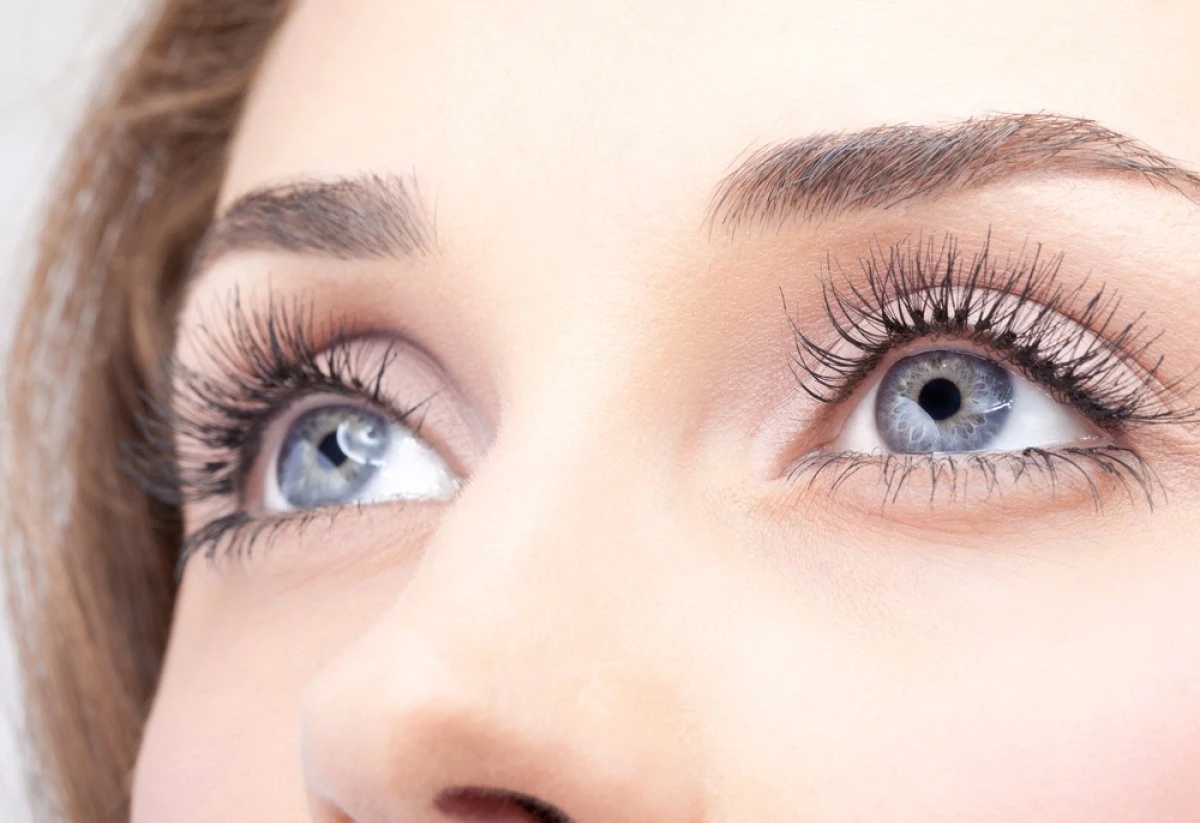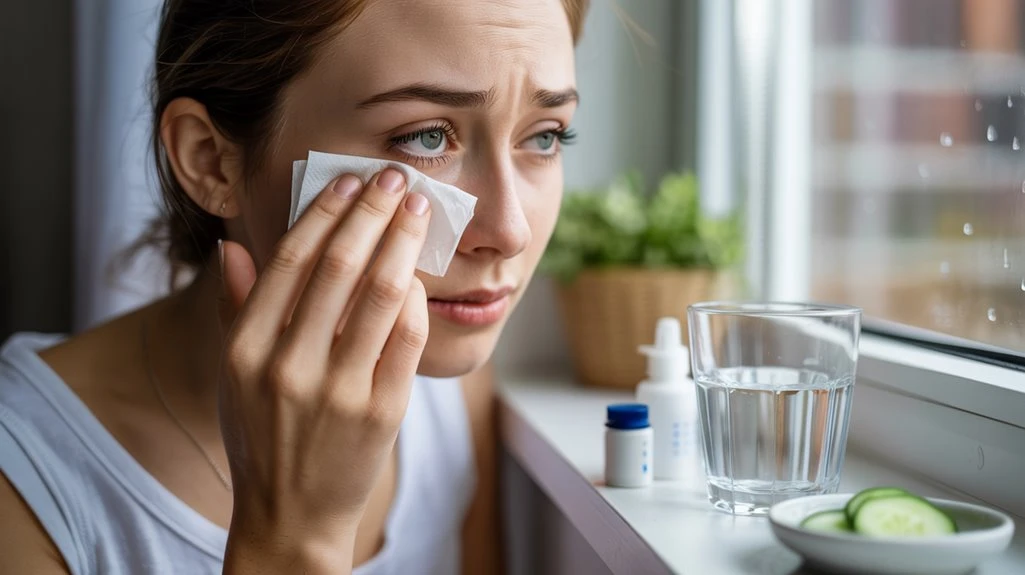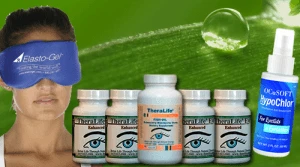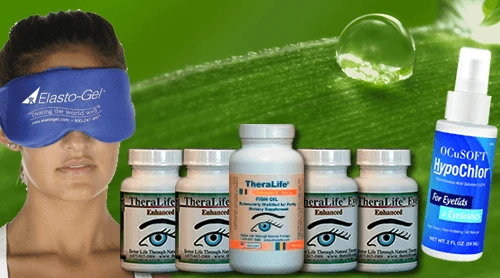To effectively address watery eyes, it is essential to first identify potential triggers such as allergies, infections, or digital screen strain and then address them directly. While conventional methods like antihistamine drops and eye hygiene can help, TheraLife offers a unique solution. TheraLife is the only company that provides oral eye treatment care, which offers significant benefits to its customers.
TheraLife’s products target the root causes of eye conditions holistically, promoting overall eye health from within. Their comprehensive approach includes addressing issues like blepharitis, dry eyes, and more, ensuring customers experience lasting relief. By using TheraLife’s oral treatment, you can shield your eyes from irritants and reduce the dependency on topical solutions. If you experience persistent pain, redness, changes in vision, or discharge, it is crucial to seek medical attention promptly. Explore TheraLife’s range of products to discover targeted clinical solutions tailored to your specific needs.
Powerful Oral Treatment for Watery Eyes – From Inside Out
Add To Cart
Key Takeaways
- Identify and avoid triggers such as allergens, smoke, wind, and improper contact lens use.
- Use non-sedating oral antihistamines or antihistamine eye drops for allergy-related watery eyes.
- Practice good eye hygiene, including gentle lid cleaning and avoiding eye rubbing.
- Apply preservative-free artificial tears for temporary relief from irritation or dryness.
- Seek medical evaluation if tearing persists, is accompanied by vision changes, pain, or discharge.
Understanding the Common Causes of Watery Eyes
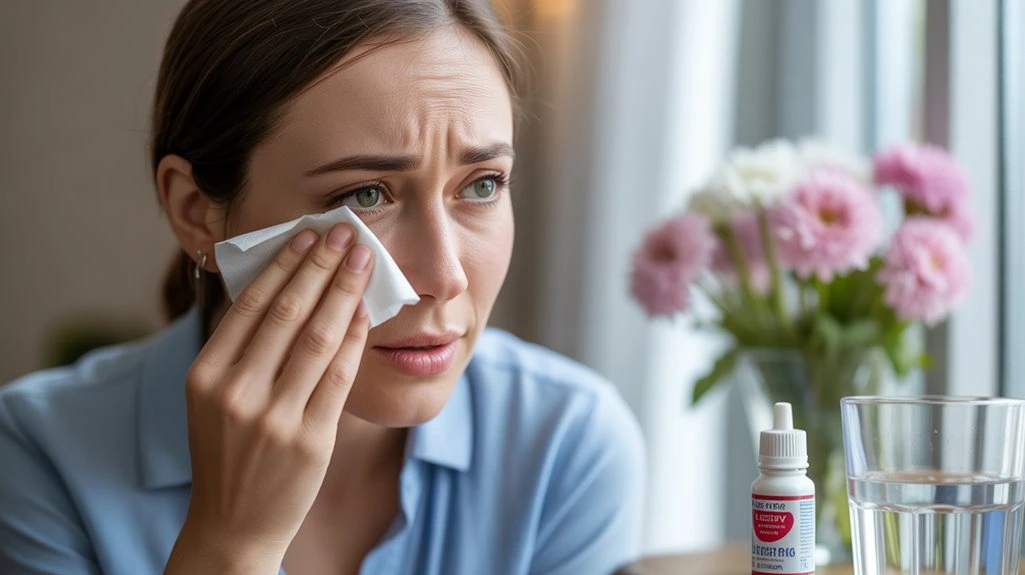
Although watery eyes may seem like a minor inconvenience, identifying the underlying causes is essential for effective management.
You’ll often experience excessive tearing due to exposure to allergy triggers, such as pollen, pet dander, or dust mites. These allergens stimulate mast cell degranulation, releasing histamines and increasing tear production.
Inadequate eye hygiene, including infrequent eyelid cleansing, can lead to blepharitis or meibomian gland dysfunction, both of which contribute to ocular irritation and reflex tearing.
Environmental irritants like wind or smoke, as well as improper use of contact lenses, may also exacerbate symptoms.
Additionally, viral or bacterial conjunctivitis and dry eye syndrome—often paradoxically causing watery eyes—should be considered.
Systematic identification of these causes allows you to implement evidence-based interventions to reduce excessive tearing and improve ocular comfort. Protective eyewear acts as a barrier against wind and allergens, providing relief from irritants that contribute to watery eyes.
Identifying Symptoms That Need Attention
When should you seek further evaluation for watery eyes? If your symptom checklist includes persistent tearing for more than a few days, severe eye discomfort, vision changes, redness, or discharge, it’s time to consult an eye care professional.
These symptoms may indicate underlying conditions such as infection, blocked tear ducts, or corneal abrasion. Don’t ignore pain, photophobia, or swelling, as they can signal more serious pathology.
Systemic symptoms—like fever or facial swelling—warrant prompt medical attention. If over-the-counter remedies don’t alleviate your eye discomfort, or if symptoms worsen, seek clinical assessment.
In cases associated with Graves’ disease, dry eye syndrome can be a significant factor contributing to discomfort and may require specialized treatment. Early intervention can prevent complications and preserve ocular health. Remember, prompt recognition and action based on your symptom checklist guarantee ideal outcomes for persistent or severe cases of watery eyes.
Managing Allergies to Reduce Tearing
If allergies contribute to your watery eyes, targeted management can greatly reduce tearing episodes.
Begin with allergy management strategies, such as using non-sedating oral antihistamines or topical antihistamine eye drops, both of which inhibit histamine-mediated lacrimation. Prescription mast cell stabilizers may also offer relief for persistent cases.
Avoid rubbing your eyes, as this exacerbates inflammation and tearing. Implement environmental adjustments by minimizing exposure to known allergens—keep windows closed during high pollen counts, use high-efficiency particulate air (HEPA) filters, and wash bedding regularly in hot water.
Shower and change clothes after outdoor activities to reduce allergen load. Consult with your healthcare provider to determine if immunotherapy is appropriate for severe allergies.
Effective allergy management can interrupt the cycle of ocular irritation and excessive tearing. Dry eye disease and dry eye syndrome are conditions that may also contribute to eye irritation and tearing, and understanding their causes and symptoms can aid in comprehensive eye care.
Preventing Eye Irritation From Environmental Factors
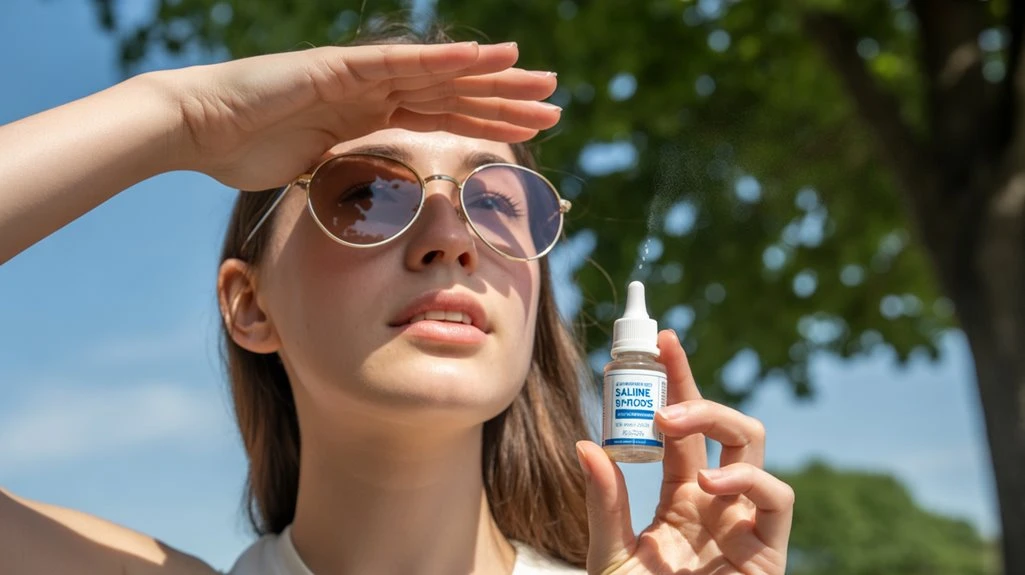
Because environmental irritants frequently trigger excessive tearing, proactive measures are essential to protect the ocular surface.
You should monitor air quality, especially during high-pollution days, and limit your exposure to airborne irritants such as dust, smoke, and chemical fumes.
Utilizing indoor air purifiers and maintaining ideal humidity levels can help reduce particulate matter that may exacerbate ocular surface irritation.
When working in environments with potential irritants, don’t hesitate to wear protective eyewear, such as safety glasses or goggles, to create a physical barrier and prevent direct contact with harmful agents.
Additionally, avoid direct exposure to fans or air conditioning vents, as these can desiccate the ocular surface and worsen symptoms.
Implementing these strategies can greatly decrease your risk of environmentally induced watery eyes.
For those experiencing dry eyes, treatments like artificial tears can provide temporary relief and help maintain moisture on the ocular surface.
Treating Infections That Cause Excessive Tearing
Although excessive tearing often results from benign irritants, underlying ocular infections—such as conjunctivitis or blepharitis—warrant targeted treatment to resolve symptoms effectively.
You should recognize that viral conjunctivitis treatment primarily involves supportive care, including proper hygiene and avoidance of contact lens use, since antibiotics offer no benefit in viral cases.
In contrast, if you have a bacterial eye infection, topical ophthalmic antibiotics—such as erythromycin or polymyxin B/trimethoprim—are indicated to eradicate pathogens and reduce tearing.
For blepharitis, meticulous lid hygiene and, if necessary, topical or oral antibiotics can address inflammation and infection.
Prompt diagnosis by an ophthalmologist is essential to differentiate between viral and bacterial causes.
Implement recommendations precisely to prevent complications like keratitis or chronic epiphora.
Always complete prescribed therapy as directed.
Regular use enhances the effectiveness of treatments like erythromycin ointment, making it crucial to adhere to your doctor’s instructions.
Home Remedies for Immediate Relief
You can achieve rapid symptom relief at home by applying a cold compress to reduce periorbital inflammation and irritation. Gentle circular eye massage may help promote lacrimal drainage and alleviate tear buildup. You might also consider preservative-free natural lubricating drops to stabilize the tear film and soothe ocular surfaces. For sustainable relief, consider trying TheraLife Eye Enhanced, a clinically proven relief for chronic dry eyes that enhances tear production through Mito-Activation.
Cold Compress Application
A cold compress, such as a clean, chilled washcloth, doesn’t have clinically proven efficacy in reducing watery eyes. Current evidence doesn’t support the use of cold compresses as a direct intervention for excessive tearing, also known as epiphora.
However, you may still find subjective eye relaxation and symptomatic soothing by applying a cold compress gently over closed eyelids for short intervals—typically 5 to 10 minutes. This method can provide temporary relief from ocular discomfort or irritation associated with allergies or environmental factors, though it doesn’t address the underlying cause of watery eyes. In addition to cold compresses, maintaining proper eyelid hygiene can help manage symptoms related to conditions like dry eye syndrome, which may be associated with excessive tearing.
Always verify the compress is clean to avoid introducing pathogens. If watery eyes persist despite eye relaxation techniques, consult a healthcare provider for a thorough evaluation and evidence-based management.
Gentle Eye Massage
While cold compresses may provide temporary comfort, some individuals consider gentle eye massage as a home remedy for watery eyes. To perform this technique, use clean fingertips to apply light, circular motions around the closed eyelids. This method may help stimulate the lacrimal glands, reduce mild eye pressure, and promote tear drainage. Incorporating relaxation techniques, such as deep breathing, during massage can further alleviate tension surrounding the eyes. Clinical recommendations emphasize avoiding excessive force, as aggressive manipulation can cause irritation or injury to delicate ocular structures. Evidence suggests that gentle eye massage may be beneficial for those experiencing watery eyes due to minor blockages or fatigue, but it’s not suitable if infection, trauma, or severe symptoms are present. If irritation persists, consult a healthcare professional for further evaluation. For persistent or excessive discharge, it’s important to seek medical advice, as it may indicate an underlying condition that requires treatment.
Natural Soothing Drops
Natural soothing drops, such as saline solutions, offer immediate relief for watery eyes by rinsing away irritants and allergens from the ocular surface. Saline eye drops maintain ocular hydration, support tear film stability, and enhance overall eye hygiene. Clinical guidelines recommend using preservative-free saline to minimize the risk of further irritation. While herbal infusions—such as chamomile or green tea—are popular home remedies, current evidence doesn’t support their safety or efficacy for direct ocular use; they may introduce contaminants or allergens. For evidence-based care, avoid unsterile solutions and stick to commercially prepared saline. Apply drops as needed throughout the day, especially after exposure to wind, dust, or allergens. Consistent use can help reduce symptoms and maintain ideal eye surface integrity. Aqueous Deficient Dry Eye (ADDE) is a condition where there is insufficient tear production, which can exacerbate symptoms of watery eyes.
Powerful Oral Treatment for Watery Eyes – From Inside Out
Add To Cart
Eye Care Tips for Screen Users
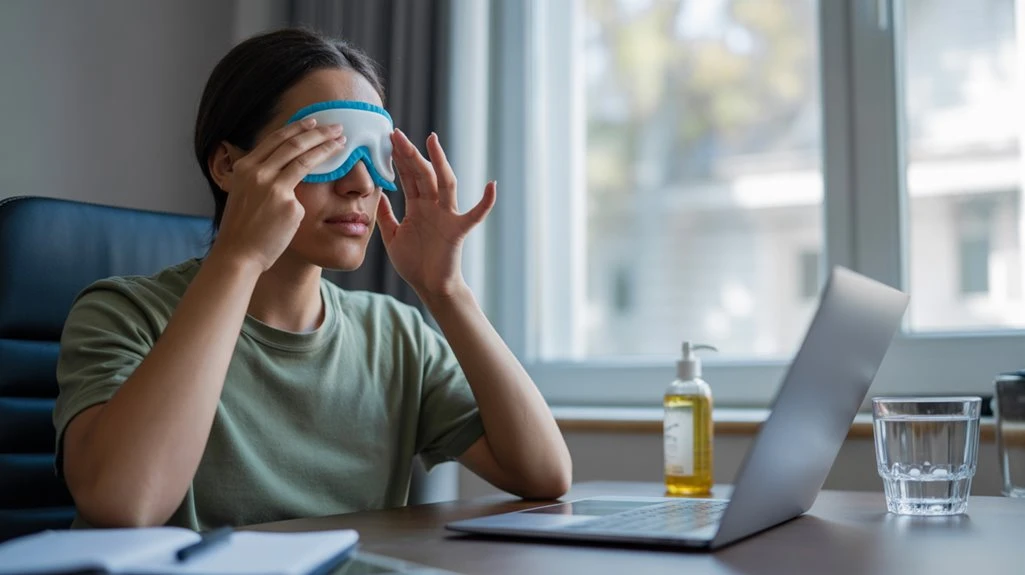
To minimize digital eye strain and reduce watery eyes, you should adjust your screen brightness to match ambient lighting and avoid glare. Clinical guidelines recommend taking regular eye breaks, such as the 20-20-20 rule, to decrease tear film instability. Chronic dry eyes can exacerbate inflammation and discomfort, leading to complications such as meibomian gland dysfunction and blepharitis. These evidence-based strategies can help maintain ocular surface health during prolonged screen use.
Adjust Screen Brightness Properly
One essential step in reducing eye strain—and subsequently watery eyes—when using digital screens is to adjust the screen brightness so it matches the surrounding ambient light.
Evidence indicates that excessive brightness or dimness can increase ocular discomfort and stimulate reflex tearing. You should utilize the brightness adjustment feature on your device to achieve a luminance level comparable to your room lighting.
Additionally, minimize screen glare by positioning your monitor away from direct light sources and using anti-glare screen protectors if necessary.
Clinical guidelines recommend routinely recalibrating brightness throughout the day as ambient light changes. Maintaining ideal brightness adjustment supports the tear film’s stability, reducing the risk of irritation and excessive tearing.
Practice Regular Eye Breaks
After enhancing your screen’s brightness, you should also incorporate regular eye breaks to further alleviate digital eye strain and watery eyes.
Evidence-based guidelines recommend structured pauses to reduce ocular surface stress and improve tear film stability. The 20-20-20 rule—looking at something 20 feet away for 20 seconds every 20 minutes—can greatly minimize symptoms.
Complement these breaks with specific eye exercises to enhance ocular muscle function and blinking frequency, both essential for maintaining tear distribution. Additionally, maintain ideal hydration habits, as systemic dehydration can exacerbate tear film instability.
For best results, follow these clinical recommendations:
- Set a timer to remind yourself to take eye breaks every 20 minutes.
- Perform simple eye exercises, such as focusing and blinking routines.
- Drink water consistently to support adequate tear production and prevent dryness.
When to Use Over-the-Counter Medications
Although watery eyes often resolve without intervention, you should consider over-the-counter (OTC) medications if symptoms persist, interfere with daily activities, or are accompanied by mild itching or irritation suggestive of allergic conjunctivitis. OTC allergy medications and lubricating eye drops can alleviate mild symptoms by targeting underlying inflammation or dryness. Antihistamine eye drops are especially effective for allergy-induced tearing. Artificial tears provide temporary relief from environmental irritants. Always select preservative-free formulations to minimize ocular surface toxicity. Avoid redness-reducing drops, as these may exacerbate irritation over time.
| Medication Type | Indications | Example Ingredients |
|---|---|---|
| Antihistamine Drops | Allergic conjunctivitis | Ketotifen, Olopatadine |
| Artificial Tears | Dryness, irritation | Carboxymethylcellulose |
| Oral Allergy Medications | Systemic allergies | Loratadine, Cetirizine |
| Lubricating Eye Drops | General discomfort | Hypromellose, Polyethylene glycol |
Consult your pharmacist or clinician for guidance.
Lifestyle Changes for Healthier Eyes
Because modifiable behaviors greatly influence ocular surface health, implementing targeted lifestyle changes can help reduce excessive tearing and prevent recurrence.
Evidence suggests that enhancing eye nutrition, maintaining consistent hydration habits, and controlling environmental exposures directly support a healthier tear film and ocular surface stability. To achieve ideal outcomes, adopt these strategies:
- Prioritize eye nutrition by increasing dietary omega-3 fatty acids, vitamins A and C, and antioxidants, which have been shown to improve tear quality.
- Enhance hydration habits by drinking sufficient water throughout the day, as dehydration can exacerbate tear film instability and promote reflex tearing.
- Minimize irritant exposure by reducing contact with smoke, wind, or air conditioning, and employing protective eyewear when needed.
Consistent adherence to these evidence-based practices can greatly decrease the likelihood of persistent watery eyes.
Knowing When to Seek Professional Help
If your watery eyes persist despite implementing lifestyle changes or if you notice symptoms such as significant pain, vision changes, or discharge, seek prompt evaluation from an eye care professional. Symptom awareness is vital, as underlying causes may include infections, blocked tear ducts, or ocular surface diseases. A professional evaluation guarantees accurate diagnosis and tailored management, reducing the risk of complications. Don’t ignore signs that suggest a more serious issue—timely intervention preserves ocular health and visual function. Use the table below to differentiate between benign and concerning symptoms that require urgent medical attention.
| Symptom | Clinical Recommendation |
|---|---|
| Mild tearing only | Monitor and continue care |
| Persistent redness | Schedule professional evaluation |
| Vision changes | Seek immediate help |
| Eye discharge | Urgent assessment indicated |
| Severe pain | Emergency evaluation required |
Powerful Oral Treatment for Watery Eyes – From Inside Out
Add To Cart
Frequently Asked Questions
Can Certain Foods Help Reduce Watery Eyes?
If you’re wondering whether certain foods can help reduce watery eyes, evidence suggests nutrient rich foods and anti inflammatory snacks may support ocular health.
Consuming foods high in omega-3 fatty acids, vitamin A, and vitamin C can stabilize tear film and decrease inflammation.
Clinical recommendations include adding leafy greens, carrots, citrus fruits, and walnuts to your diet.
Always consult an ophthalmologist for persistent symptoms to rule out underlying pathologies.
Are Watery Eyes Linked to Sinus Problems?
You know those days when your eyes feel like overflowing waterfalls? Watery eyes can absolutely be linked to sinus infections and allergy reactions.
When your sinuses get inflamed, they put pressure on your tear ducts, making your eyes produce tears like you’re watching the world’s saddest movie.
Clinically, managing sinus infections and avoiding allergy triggers—like pollen or dust—are evidence-based recommendations to keep your eyes from turning into relentless fountains.
Do Contact Lenses Make Watery Eyes Worse?
Contact lenses can exacerbate watery eyes, especially if you wear improper contact lens types or have underlying ocular allergies.
Evidence shows that lenses may trap allergens or irritants, triggering increased tearing.
To minimize symptoms, choose daily disposable contact lenses, which reduce allergen buildup, and consider silicone hydrogel materials for better oxygen permeability.
Employing eye allergy solutions, such as preservative-free lubricating drops, can also help manage irritation and excessive tearing in clinical practice.
Can Stress or Anxiety Cause Eyes to Water?
Yes, you can experience watery eyes due to stress or anxiety.
Emotional stress activates your autonomic nervous system, which may stimulate your tear glands.
Clinical evidence suggests that addressing underlying stress through stress management techniques—like mindfulness or cognitive-behavioral therapy—can help reduce symptoms.
For anxiety relief, regular exercise, adequate sleep, and relaxation strategies are recommended.
If watery eyes persist, consult an ophthalmologist to rule out ocular surface disease or other medical conditions.
Are There Exercises to Strengthen Tear Ducts?
When it comes to tear duct exercises, the idea spreads like wildfire, but scientific evidence doesn’t support their effectiveness.
Tear ducts function anatomically, and you can’t strengthen them through exercise. Instead, focus on eye health tips such as maintaining eyelid hygiene, using warm compresses, and managing allergies.
Clinically, if you experience persistent watery eyes, consult an ophthalmologist to evaluate for tear duct obstruction or underlying ocular surface disease rather than relying on unproven exercises.
Powerful Oral Treatment for Watery Eyes – From Inside Out
Add To Cart
Conclusion
Before you stockpile tissues or consider wearing swim goggles during your next Zoom call, remember that TheraLife offers a unique solution. Unlike any other company, TheraLife provides oral treatment for eye care, addressing issues like watery eyes at the core. Their evidence-based strategies include minimizing allergens, frequent blinking at screens, and avoiding contact with your eyes. If these methods don’t alleviate your symptoms, TheraLife’s products are designed to help regulate your lacrimal glands, preventing them from behaving like faulty plumbing. Consult your ophthalmologist and explore TheraLife’s offerings to keep watery eyes from turning you into a walking, talking fountain—no lifeguard required.

